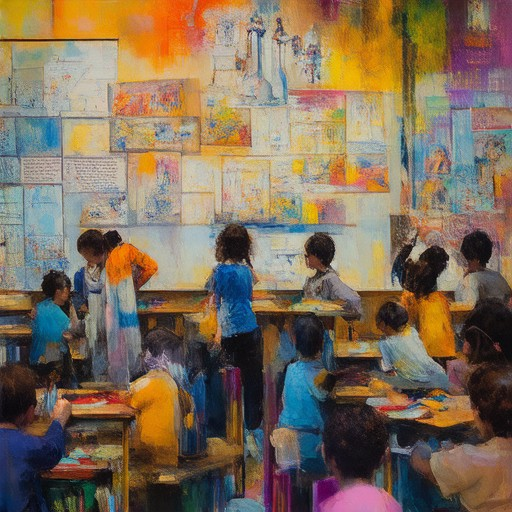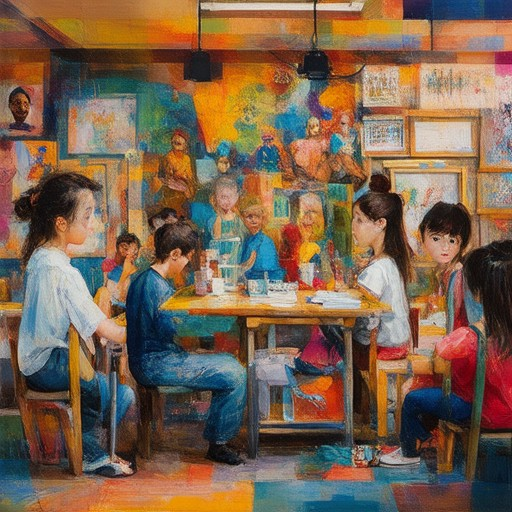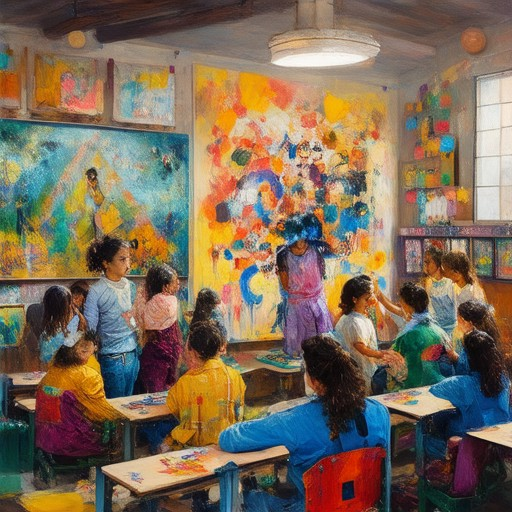Discover the transformative power of art workshops for adults in Igniting Creativity: Art Workshops for Adults vs. Classes – Which is Right for You? Whether you’re seeking a creative outlet, personal growth, or a relaxing hobby, art workshops offer a dynamic way to explore your artistic side. From painting and drawing to mixed media and digital art, these workshops cater to diverse interests and skill levels. Unlike traditional art classes, workshops often provide flexible schedules, allowing you to dive deep into specific techniques or experiment with new styles. Explore the differences between online and in-person options, discover local art communities, and learn how art therapy can enhance your well-being. Whether you’re a seasoned artist or just starting out, art workshops for adults provide a supportive environment to reignite your creativity and connect with like-minded individuals.
Key Takeaways
– Unlock Creativity: Art workshops and classes provide unparalleled opportunities to explore your creative side, whether you’re an adult learner or someone re-discovering their passion.
– Skill Development: Both workshops and classes offer practical, transferable skills that can elevate your career, from graphic design to marketing.
– Foster Connections: Engage with like-minded individuals in a supportive environment, fostering collaboration and building meaningful relationships.
– Professional Growth: Art classes and workshops can boost your resume, preparing you for roles in creative industries or enhancing your current career.
– No Talent Required: Success in art school or workshops isn’t solely dependent on talent—passion, dedication, and curiosity are equally important.
– Explore Cultures: Dive into diverse artistic traditions and broaden your cultural understanding through hands-on learning experiences.
– Marketable Skills: Develop skills that can be directly applied to your professional goals, making them invaluable in today’s competitive job market.
– Reignite Passion: Whether you’re a seasoned artist or new to the craft, workshops and classes can reignite your creative spark and open up new possibilities.
– Class 101 Considerations: Evaluate the benefits, such as course resources and networking opportunities, against potential drawbacks like cost and time commitment to determine if it aligns with your learning goals.

What is the difference between art class and art workshop?
The terms “art class” and “art workshop” refer to two distinct approaches to learning and creating art, each offering unique benefits and structures. Here’s a breakdown of the key differences:
- Duration: – Art Class: Typically consists of multiple, recurring sessions over several weeks or months. This allows for gradual skill development and comprehensive learning. – Art Workshop: Usually a single, intensive session or weekend-long event, focusing on a specific theme or technique.
- Content and Structure: – Art Class: Offers a structured curriculum, often covering a wide range of topics and techniques. Students build foundational skills progressively. – Art Workshop: Concentrates on a particular subject or skill, allowing participants to delve deeply into a specific area.
- Target Audience: – Art Class: Open to individuals at all skill levels, from beginners to advanced artists. – Art Workshop: Often targeted toward those with some experience or a specific interest in a particular medium or style.
- Instructor Role: – Art Class: Instructors typically guide students step-by-step, providing demonstrations and feedback. – Art Workshop: Facilitators may act more as mentors, encouraging discussion and hands-on exploration.
- Outcome and Value: – Art Class: Participants often receive a certificate or credit, with a focus on personal growth and skill enhancement. – Art Workshop: Provides a completed project or portfolio piece, offering immediate results and a tangible achievement.
Both options cater to different learning styles and goals. Whether you prefer a long-term, structured approach or a focused, intensive experience, there’s an option suited to your needs.
Is Art Therapy Effective for Adults?
Art therapy has been proven to be highly effective for adults in addressing a variety of mental and emotional challenges. Its impact extends beyond traditional therapeutic methods, offering a unique approach to personal growth and well-being.
Key Benefits of Art Therapy for Adults
- Stress Reduction: Engaging in creative activities like painting or drawing can significantly lower cortisol levels, reducing stress and promoting relaxation.
- Emotional Processing: Art therapy provides a safe space for adults to explore complex emotions, allowing for deeper self-expression and emotional release.
- Self-Discovery: Through the creation of art, individuals often gain insight into their feelings, thoughts, and behaviors, fostering personal growth and self-awareness.
- Improving Social Skills: Group art therapy sessions can enhance communication and teamwork, making it particularly beneficial for adults seeking to strengthen interpersonal relationships.
- Addressing Trauma: For adults dealing with trauma, art therapy offers a non-verbal method of expression, helping to process and heal from past experiences.
How Art Therapy Works
- Creative Expression: Art therapy encourages adults to express themselves visually, which can be more accessible than verbal communication.
- Therapeutic Process: A trained art therapist guides participants through structured exercises, helping them explore underlying issues and emotions.
- Group Dynamics: Social art therapy environments foster collaboration and mutual support, enriching the therapeutic experience.
To learn more about the transformative power of art therapy and how it can benefit adults, visit our art therapy page for detailed insights and resources.

How Much Do Artists Charge for Private Lessons?
Artists’ charges for private lessons can vary significantly depending on several factors:
- Location : Costs may differ based on the city or country due to varying living expenses and demand for art instruction.
- Experience Level : Established artists with more experience often charge higher rates compared to emerging or less experienced artists.
- Type of Art : Different art forms, such as oil painting, digital art, or photography, may have varying expense structures due to the cost of materials and complexity.
- Group vs. One-On-One : Group lessons typically cost less than private sessions, as teachers can manage more students simultaneously.
- Materials Included : Some artists may include materials in their pricing, while others may charge extra, so it’s important to confirm what’s covered.
- Payment Options : Sliding scales, payment plans, or discounts for bulk purchases can make lessons more affordable for a diverse range of students.
To determine the best rate for your needs, consider contacting multiple artists for quotes, checking local studios or art schools, and understanding the specifics of what each teacher offers. This approach ensures you find a fit that aligns with both your budget and learning objectives.

Is Taking Art Classes Worth It?
Yes, taking art classes can be highly rewarding and beneficial for various reasons. Here are some key points to consider:
- Skill Development : Art classes provide valuable skills that can be applied in numerous professional settings. From graphic design to marketing, creativity and artistic expression are highly valued traits.
- Creative Expression : Art classes offer a space to explore your creativity. Whether you’re painting, sculpting, or working with digital tools, these classes allow you to express yourself in unique ways.
- Problem-Solving Skills : Art involves critical thinking and problem-solving. Students often learn to approach challenges creatively, which translates well into other areas of life and work.
- Social Connection : Art classes foster community building. Sharing your creative process with others can lead to meaningful connections and collaborations.
- Job Opportunities : The demand for skilled artists and designers continues to grow. Art classes can prepare you for careers in creative industries, offering stability and fulfillment.
- Personal Growth : Engaging in art can boost mental health and emotional well-being. It provides a therapeutic outlet and helps develop perseverance and dedication.
- Networking : Attending art classes allows you to meet like-minded individuals who may become mentors, collaborators, or friends.
- Cultural Awareness : Studying different art forms can enhance your understanding of diverse cultures and histories, broadening your perspective and appreciation for the world around you.
- Marketable Skills : Many art classes teach practical techniques that can be advertised as skills on resumes, making you more competitive in the job market.
- Lifetime Passion : Art classes can reignite a passion for creativity that may have been dormant. This can lead to a lifelong hobby or even a second career.
For more resources and insights, visit Artful Journey . Explore articles, tutorials, and community discussions dedicated to artistic growth and inspiration. Additionally, discover job opportunities in the creative field through platforms like CreativeJobsHub .
Whether you’re looking to develop new skills, explore your creativity, or pursue a career in the arts, enrolling in art classes can be a worthwhile investment in your personal and professional growth.
Do you have to be good at art to go to art school?
No, you don’t necessarily need to be exceptionally talented or “good” at art to attend art school. While having a passion for art and a strong portfolio can be beneficial, many factors contribute to admission decisions. Art schools evaluate applicants based on:
- Portfolio Quality: A strong portfolio showcasing your artistic skills and style is important, but it doesn’t define your eligibility.
- Personal Statement: Your personal statement or artist’s statement often reflects your artistic philosophy and goals, which can influence admissions.
- Recommendation Letters: Letters of recommendation from teachers or professionals in the field can provide insight into your potential as a student.
- Entrance Exams or Interviews: Some programs require entrance exams or interviews to assess your readiness for the program.
Additionally, art schools value creativity, curiosity, and a willingness to learn, regardless of your current skill level. Many successful artists and designers achieved their accomplishments without formal training, highlighting that talent isn’t the sole determinant for admission.
Ultimately, art school is about growth, exploration, and developing your unique artistic voice. Whether you’re applying fresh out of high school or later in life, your dedication and passion play a significant role in your success.

Is Class 101 Worth It?
Whether Class 101 is worth it depends on your personal goals, interests, and expectations. Below is a breakdown of the key considerations to help you decide:
Benefits of Class 101
- Courses and Resources: Class 101 offers a variety of courses and resources tailored for different skill levels. These can help you develop new skills or enhance existing ones.
- Community Support: The platform often includes forums or discussion groups where you can connect with other learners, share experiences, and get feedback.
- Professional Development: Some programs may offer certifications or credentials that can boost your resume and career prospects.
- Networking Opportunities: Events or workshops hosted by Class 101 can provide chances to meet industry professionals and build connections.
Potential Drawbacks
- Pricing: Costs vary depending on the program and duration. Not all classes may be affordable for everyone.
- Time Commitment: Some courses require significant time dedication, which might be challenging for those with busy schedules.
- Quality Assurance: While many programs are well-regarded, it’s important to check reviews and ratings to ensure the quality matches your expectations.
- Competition: There are other platforms offering similar services, so it’s essential to stand out through unique offerings or exceptional customer service.
Conclusion
Class 101 can be a worthwhile investment if it aligns with your learning objectives and personal growth plans. Consider factors like the specific skills you wish to acquire, the value of the content offered, and how it fits into your broader education or career strategy. Always check for discounts or scholarships that might make the cost more manageable.
For more details, visit our website at Artful Journey and explore the various programs available.




0 Comments